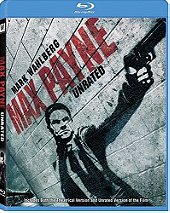When a director adapts a video game to film, he/she has one of two choices. This person can either stick closely to the source material and make a mess of the story and characters because, as much as we think differently, video games are not made to be directly adapted to nearly any other form of media. The other way said director may go about this is the same manner in which Max Payne director John Moore has; keep it similar to the video games in mood, atmosphere, and spirit, but alter characters and plot points to better fit the filmic universe.
A good percentage of the Max Payne faithfuls have complained that too much was changed during its transition from computer monitor to TV screen. Some of the bigger examples being no graphic dream sequences, Jim Bravura being African-American (and Internal Affairs instead of Chief of Police), no Vinnie Gognitti, Frankie "The Bat" Niagra, Rico Muerte (or any of the Punchinello crime family for that matter), Alfred Woden, and an ending that, indeed, does have similarities to the conclusion of the first game, but exhibits the death of a completely different character. There are, however, many other characters from the Max Payne universe that do put in appearances, as well as several of the key locations. As far as locations are concerned, the Aesir Building, Roscoe Street Station, and Ragnarok are in the film; and arguable Max Payne favorites B.B. Hensley, Jim Bravura, Nicole Horne, Mona & Natasha Sax, Jack Lupino, Michelle Payne, and even Alex Balder are present and accounted for.
What the film lacks in cosmetic and plot-based similarities to its source material, it makes up for with grim atmosphere and a noir-ish, Sin City-like look and grit that mirrors that of its video game counterpart. The snowy backdrops are a constant and every single shot is dimly lit and featured in some seedy, shadowy location. Characters like Lupino and Nicole Horne look exactly as they appeared in the first game, and even Max Payne himself is brought to life through many small, but notable touches (Lupino's tattoos and trademark "drug-induced babbling" are spot-on and Max's hairstyle and "scrunched face" look are perfect). It's unarguable in this man's opinion that Mark Wahlberg was miscast as the titular Max Payne, but he pulled off the character well. Surprisingly, this unrated cut features some additional material that plays more to Max's suicidal/homicidal angle that was so prevalent in the games.
The biggest complaint of all, however, was that for a game that featured intense, slow-motion shootouts so consistently, its live-action adaptation was disappointingly light on them. It wasn't until the flick's third act that there was any kind of real fireworks. Where the game had an even eight hours that could be spread evenly between plot and character development, as well as action sequences, one must keep in mind that that the film has roughly an hour and 45 minutes to do so. Moore's adaptation opts to be more of a noir-like mystery that utilizes its few action sequences to complement the film’s intense atmosphere and visceral approach rather than as the main attraction.
I will admit to appreciating the time that was invested in creating tension, mood, and introducing & developing characters as opposed to simply giving us just another half-baked shoot 'em up. Max Payne takes its sweet time to get going, but the visuals are striking and the chemistry between the actors is superb. For an action flick that runs as long as this one, each minute seems like time well spent. On a more negative note, I can imagine that anyone who hasn't played the games would find more satisfaction in the film's conclusion, but for fans of the franchise, it won't be anything new (the movie follows each of the first game's twists and turns to the number, for better or worse).
Specifically related to the unrated cut, this version of Max Payne looks, feels, and acts like an R-rated movie. There is more profanity sprinkled throughout (by my count, four or five more 'F' words have been added, two with the prefix "mother"), a much darker feel presented by way of eerie camera shots and a more morbid tone (a good example being the extended take of Max peering in through the door at a "party" one of his "friends" is hosting), and more violence. Each scene of violence is accompanied by either blood-release squibs or digital blood that has, of course, been added in after the fact (sometimes they are both used together). Where these FX are most noticeable are in the Aesir Building shootouts and in the home invasion flashback. Even with only three minutes added back into the movie, these additions are very major and change the texture of the film considerably.
Even without the unrated cut, the PG-13 version was one of, if not the best, video game adaptations I had ever seen. Stellar direction and a brutally down-trodden atmosphere lent to the film's credence. Those of you who didn't care for the theatrical print - in its entirety - will find no reason to like this, but those who did will certainly find this to be truer to the Max Payne universe than Moore’s initial cut. Even minus the added violence and copious amounts of bloodshed, the pathos of the Max Payne character has been fleshed out more and the tone of the film is, surprisingly, even bleaker than the rated print. This is definitely one of the most faithful video game adaptations you will find.
8/10
 Login
Login